Abstract
Currently, a software-based second check dose calculation for helical tomotherapy (HT) is not available. The goal of this study is to evaluate the dose calculation accuracy of the in-house software using EGS4/MCSIM Monte Carlo environment against the treatment planning system calculations. In-house software was used to convert HT treatment plan information into a non-helical format. The MCSIM dose calculation code was evaluated by comparing point dose calculations and dose profiles against those from the HT treatment plan. Fifteen patients, representing five treatment sites, were used in this comparison. Point dose calculations between the HT treatment planning system and the EGS4/MCSIM Monte Carlo environment had percent difference values below 5 % for the majority of this study. Vertical and horizontal planar profiles also had percent difference values below 5 % for the majority of this study. Down sampling was seen to improve speed without much loss of accuracy. EGS4/MCSIM Monte Carlo environment showed good agreement with point dose measurements, compared to the HT treatment plans. Vertical and horizontal profiles also showed good agreement. Significant time saving may be obtained by down-sampling beam projections. The dose calculation accuracy of the in-house software using the MCSIM code against the treatment planning system calculations was evaluated. By comparing point doses and dose profiles, the EGS4/MCSIM Monte Carlo environment was seen to provide an accurate independent dose calculation.







Similar content being viewed by others
References
Fenwick JD, Tome WA, Soisson ET et al (2006) Tomotherapy and other innovative IMRT delivery systems. Semin Radiat Oncol 4:199–208
Mackie TR, Balog J, Ruchala K et al (1999) Tomotherapy. Semin Radiat Oncol 1:108–117
Stathakis S, Li J, Ma CC (2007) Monte Carlo determination of radiation-induced cancer risks for prostate patients undergoing intensity-modulated radiation therapy. J Appl Clin Med Phys 8:2685
Mackie TR (1990) Applications of the Monte Carlo method in radiotherapy. In: Kase DK, Bjarngard BE, Attix FH (eds) The dosimetry of ionizing radiation, vol III. Academic, New York, pp 541–620
Rogers DW, Faddegon BA, Ding X, Ma CM, We J, Mackie TR (1995) BEAM: a Monte Carlo code to simulate radiotherapy treatment units. Med Phys 22:503–524
Yang J, Li JS, Qin L, Xiong W, Ma CM (2004) Modelling of electron contamination in clinical photon beams for Monte Carlo dose calculation. Phys Med Biol 49:2657–2673
Ma CM, Faddegon BA, Rogers DWO, Mackie TR (1997) Accurate characterization of the Monte Carlo calculated electron beams for radiotherapy. Med Phys 24:401–417
Miften M, Wiesmeyer M, Kapur A, Ma CM (2001) Comparison of RTP dose distributions in heterogeneous phantoms with the BEAM Monte Carlo simulation system. J Appl Clin Med Phys 2:21–31
Ma CM, Li JS, Pawlicki T, Jiang SB, Deng J (2002) MCSIM users manual, internal report no: FCCC-RADPHYS-0201, pp 1–25
Ma CM, Li J, Pawlicki T et al (2004) MCSIM—a Monte Carlo dose calculation tool for radiation therapy. In: Yi BY, Ahn SD, Choi EK, Ha SW (eds) Proceedings of the XIVth international conference on the use of computers in radiation therapy (ICCR). Jeong, Seoul, pp 515–519
Fan J, Li J, Chen L, Stathakis S, Luo W, Du Plessis F, Xiong W, Yang J, Ma CM (2006) A practical Monte Carlo MU verification tool for IMRT quality assurance. Phys Med Biol 10:2503–2515
Flampouri S, Jiang SB, Sharp GC, Wolfgang J, Patel AA, Choi NC (2006) Estimation of the delivered patient dose in lung IMRT treatment based on deformable registration of 4D-CT data and Monte Carlo simulations. Phys Med Biol 51:2763–2779
Kutcher GJ, Coia L, Gillin M et al (1994) Comprehensive QA for radiation oncology: report of AAPM radiation therapy committee task group 40. Med Phys 4:581–618
Haslam JJ, Bonta DV, Lujan AE et al (2003) Comparison of dose calculated by an intensity modulated radiotherapy treatment planning system and an independent monitor unit verification program. J Appl Clin Med Phys 3:224–230
Gibbons JP, Smith K, Cheek D et al (2009) Independent calculation of dose from a helical tomotherapy unit. J Appl Clin Med Phys 1:2772
Mukumoto N, Tsujii K, Saito S et al (2009) A preliminary study of in-house Monte Carlo simulations: an integrated Monte Carlo verification system. Int J Radiat Oncol Biol Phys 2:571–579
Pisaturo O, Moeckli R, Mirimanoff RO et al (2009) A Monte Carlo-based procedure for independent monitor unit calculation in IMRT treatment plans. Phys Med Biol 13:4299–4310
Tsai JS, Engler MJ, Liu J (2002) Quasi-independent monitor unit calculation for intensity modulated sequential tomotherapy. J Appl Clin Med Phys 2:135–153
Wang L, Chui CS, Lovelock M (1998) A patient-specific Monte Carlo dose-calculation method for photon beams. Med Phys 6:867–878
Papanikolaou N, He W, Vazquez LA, Gutierrez A, Stathakis S, Alkhatib H, Shi C (2010) MU-Tomo: independent dose validation software for helical tomotherapy. J Cancer Sci Ther 2:145–152
Sellakumar P, Arun C, Sanjay SS, Ramesh SB (2011) Comparison of monitor units calculated by radiotherapy treatment planning system and an independent monitor unit verification software. Phys Med 27:21–29
Chen L, Chen LX, Huang SM, Sun WZ, Sun HQ, Deng XW (2010) Independent verification of monitor unit calculation for radiation treatment planning system. Chin J Cancer 29:217–222
Ryczkowski A, Piotrowski T (2011) Tomotherapy archive structure and new software tool for loading and advanced analysis of data contained in it. Rep Pract Oncol Radiother 16:58–64
Nelson WR, Hirayama H, Rogers DW (1985) Report no: SLAC-265
Thomas SJ, Eyre KR, Tudor GSJ, Fairfoul J (2012) Dose calculation software for helical tomotherapy, utilizing patient CT data to calculate an independent three-dimensional dose cube. Med Phys 39:160–167
Author information
Authors and Affiliations
Corresponding author
Rights and permissions
About this article
Cite this article
Dzintars, E., Stathakis, S., Mavroidis, P. et al. Performance of independent dose calculation in helical tomotherapy: implementation of the MCSIM code. Australas Phys Eng Sci Med 35, 423–438 (2012). https://doi.org/10.1007/s13246-012-0165-x
Received:
Accepted:
Published:
Issue Date:
DOI: https://doi.org/10.1007/s13246-012-0165-x




